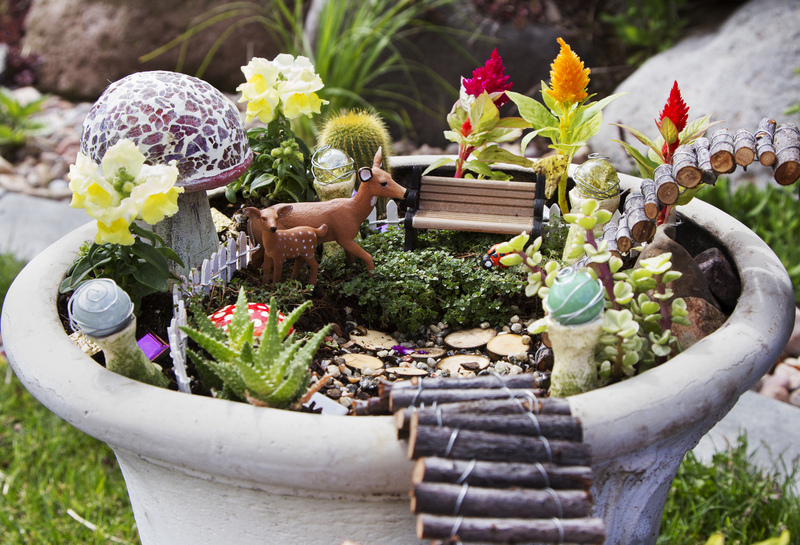Steps to Build an Interactive and Child-Friendly Garden
Posted on 16/06/2025
Introduction: Creating a Safe and Engaging Garden for Children
A garden is much more than just a space for plants and flowers--it's a place where families grow together, where kids can learn, play, and connect with nature. Designing an interactive and child-friendly garden is a fantastic way to inspire curiosity, enhance outdoor play, and nurture responsibility in children. If you're seeking to transform your outdoor area into a vibrant haven for young ones, this guide will walk you through every step, providing creative ideas, safety tips, and practical solutions.

Why Build a Kid-Centric Garden?
Building an interactive garden for children taps into the natural curiosity and energy of kids while helping them develop a lifelong appreciation for the outdoors. Outdoor spaces designed with children in mind foster valuable skills, such as collaboration, sensory exploration, and environmental responsibility. Plus, these gardens offer an antidote to screen time, creating opportunities for hands-on discovery and healthy exercise.
Essential Steps to Create a Child-Friendly and Interactive Garden
Embarking on a project to craft an engaging garden for children involves thoughtful planning and creativity. Here's a step-by-step process you can follow to ensure your garden is safe, stimulating, and full of lasting memories.
Step 1: Assess Your Space and Involve the Kids
Before breaking ground, examine your yard or garden area:
- Measure the available space--understand what you can do within your area's limitations.
- Look for hazards such as sharp tools, poisonous plants, or uneven terrain that need to be addressed.
- Involve your children in the planning. Ask for their input: What do they want to play or grow? Which colors or features excite them?
Tip: Creating a garden with your children, not just for them, increases their sense of ownership and excitement!
Step 2: Design an Inviting and Safe Layout
Safety is the cornerstone of any child-friendly garden. Consider these key aspects to ensure the environment is both fun and secure:
- Fencing: Install safe boundaries with fencing or natural hedges to define the garden and keep children contained. Ensure there are no protruding wires or dangerous spikes.
- Visibility: Position play and interactive zones where they're easily visible from the house or a seating area.
- Pathways: Construct smooth, non-slip pathways (like bark chip, rubber mulch, or flat stones) for safe movement around the garden.
- Storage: Set up dedicated spaces for tools, toys, and potentially hazardous substances, stored well out of children's reach.
Step 3: Choose Non-Toxic, Child-Friendly Plants
Selecting the right plants is crucial in an interactive child-friendly garden. Opt for non-toxic, low-maintenance varieties that thrive in your climate. Here are great plant options for kids:
- Edibles: Strawberries, cherry tomatoes, snap peas, carrots, lettuces. Watching food grow is magical for children!
- Sensory plants: Lamb's ear (soft leaves), mint (fragrant), sunflowers (tall and dramatic), nasturtiums (vibrant edible flowers).
- Hardy ornamentals: Marigolds, pansies, calendula--easy and colorful annuals that survive handling.
Eliminate toxic species such as foxglove, oleander, monkshood, and yew. Always double-check before planting.
Step 4: Incorporate Inspiring Interactive Elements
True to its name, an interactive garden for children features hands-on activities that encourage exploration, inquiry, and fun.
- Raised beds or planter boxes: Perfect for little arms to dig and plant seedlings; easier to tend and less compacted soil.
- Miniature gardening areas: Create fairy gardens, dinosaur landscapes, or tiny "farm plots" to captivate imagination.
- Water play stations: Install shallow basins for splashing, or a small bird bath for eco-friendly fun. Always supervise water play!
- Bug hotels and butterfly feeders: Teach children about beneficial insects by providing habitats made from bamboo, pine cones, and sticks.
- Stepping stones or garden trails: Lay a winding path of decorated stones for games and navigation practice.
- DIY outdoor chalkboard: Attach a weatherproof board to a fence for art-time in the sunshine.
Interactive features unlock new ways for kids to experience the garden--encouraging creativity, physical activity, and scientific curiosity.
Step 5: Promote Hands-On Learning and Discovery
A kid-friendly garden is an excellent classroom! Build learning into your landscape with these playful, practical ideas:
- Plant life cycles: Let children sow seeds, water young plants, and track their progress in a garden journal.
- Composting corner: Teach sustainability by making a simple compost pile or using a compost tumbler--kids love feeding it kitchen scraps!
- Weather station: Add a rain gauge, wind sock, or even a thermometer to turn your outdoor space into a science lab.
- Wildlife observation: Put up nesting boxes or feeders and count the birds, bees, and butterflies that visit.
Fostering nature-based learning in your garden bolsters STEM skills while building a deeper, more respectful connection to the natural world.
Step 6: Plan for Play, Movement, and Relaxation
A vibrant child-friendly landscape includes a balance of activities. Make space for:
- Active play areas: Swing sets, mini climbing frames, slides, or a designated area for ball games. Use soft surfacing underneath to prevent injuries.
- Quiet nooks: Create cozy hiding places with willow teepees, tree stumps, or a "reading fort," giving kids a calm space to unwind and daydream.
- Picnic zone: Lay out a mat or build a simple wooden table for snack times, art, or tea parties outdoors.
The best gardens mix energetic zones with peaceful spots, offering something special for every mood.
Step 7: Emphasize Accessibility and Inclusion
When constructing an inclusive interactive garden for kids, consider accessibility for all children, including those with disabilities:
- Raised beds and wide paths help wheelchair users or children who find ground-level gardening difficult.
- Sensory gardens with plants of varied colors, textures, and scents engage all children, including those with sensory challenges.
- Adapted play equipment and seating make the space usable for everyone in the family.
A truly child-friendly garden is welcoming to all, fostering empathy, collaboration, and friendship.
Step 8: Engage the Senses for Maximum Enjoyment
Children naturally learn and play through their senses, so design your kids' garden to delight them:
- Sight: Brightly colored flowers, varied foliage, playful garden art, and flags stimulate visual curiosity.
- Touch: Contrasting textures--fuzzy lamb's ear, crunchy bark, smooth pebbles, and cool water.
- Smell: Fragrant herbs (lavender, rosemary), sweet flowers (honeysuckle, sweet peas), and the rich aroma of damp earth.
- Sound: Ornamental wind chimes, bird song, rustling grasses, or the gentle trickle of a mini fountain.
- Taste: Edible gardening allows children to sample fresh, home-grown produce right from the soil.
An engaging, multi-sensory garden is a magical place kids will return to again and again.
Step 9: Incorporate Seasonal Variety and Year-Round Interest
Keep your child-friendly yard attractive and interactive in every season by mixing:
- Spring bulbs for early color (daffodils, crocuses, tulips)
- Summer edibles and annual flowers (tomatoes, sunflowers, zinnias)
- Autumn foliage and harvest (pumpkins, apples, ornamental grasses)
- Winter evergreens and interest from bird feeders, wind chimes, or hardy sculptures
Teach children how nature changes, and bring gardening activities inside in cold weather with windowsill planting or nature crafts.
Step 10: Encourage Imagination and Storytelling
Spark the creative power of your children by designing zones that invite stories and make-believe play:
- Fairy doors on tree trunks, hidden gnomes, or whimsical signs bring a sense of magic.
- Natural construction materials: Provide sticks, logs, and stones for fort building and open-ended play.
- Art projects: Install an area for painting rocks, making leaf rubbings, or weaving natural materials.
A child-focused interactive garden is a canvas limited only by imagination!
Maintenance Tips for Child-Safe and Interactive Gardens
An engaging and safe garden requires ongoing care. Keep your child-friendly landscape healthy and inviting with these tips:
- Regular checks: Inspect for hazards--sharp tools left out, tripping obstructions, broken play equipment, or poisonous plants.
- Weed management: Minimize chemical use; opt for hand weeding or mulching to keep the environment natural and safe.
- Watering schedules: Involve children in responsible watering routines using small, lightweight watering cans.
- Rotate activities: Refresh interactive zones and introduce new games or seasonal features to maintain interest all year round.
Involve children in simple, supervised garden chores--it builds pride in their environment and valuable life skills.

Frequently Asked Questions About Interactive and Child-Friendly Gardens
What are the best plants for a child-safe garden?
Always use non-toxic, robust varieties. Edible favorites like strawberries, cherry tomatoes, snap peas, and carrots are wonderful, along with sunflowers, marigolds, nasturtiums, and pansies. Double-check all plant choices for toxicity before planting.
How do I make my garden both safe and stimulating?
Remove hazards, use soft surfaces and secure fencing, and design varied activity zones. Balance energetic play spaces with areas for creativity, learning, and relaxation.
Can I build an interactive garden in a small space?
Yes! Use vertical gardening, container plants, compact play features, and window boxes. Even a balcony or compact yard can become a miniature wonderland for children.
Conclusion: Grow More Than Just Plants
Building an interactive and child-friendly garden is an investment in your children's health, happiness, and development. By following these comprehensive steps--from planning and plant selection to safety, inclusivity, and creativity--you cultivate a yard where imaginations flourish and family bonds grow strong.
Whether your garden is sprawling or tiny, urban or rural, making it safe, engaging, and educational brings outsized rewards. Start planning your child-first outdoor sanctuary today--and watch your garden, and your kids, thrive together.



